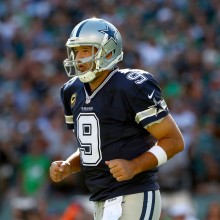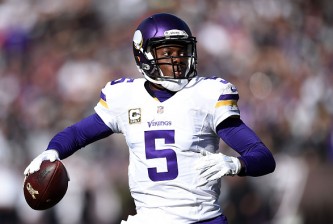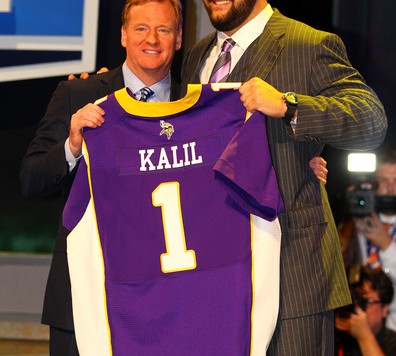Chicago Bears: C+
The Bears met one of their most important needs before the draft began by reuniting Jay Cutler with wideout Brandon Marshall thanks to a trade with the Miami Dolphins. With Marshall in the fold, wide receiver went from a near “must have” to a “would be nice to have,” especially if Johnny Knox is misses some or much of the regular season. Beyond receiver, more quality bodies on the offensive line looked like a priority, as did potentially a starting defensive end, and better defensive back depth.
The result of Phil Emery’s first draft was a bunch of “ifs.” First-round pick Shea McClellin could nail down the starting defensive end spot opposite Julius Peppers if he adjusts to playing defensive end full-time and holds up okay in run defense. Second-round pick Alshon Jeffery could be another big-target for Culter if he keeps his weight closer to 215 than 250. Third-round pick Brandon Hardin could be a big-time safety if the shoulder injury that cost him all of the 2011 season doesn’t provide any lingering effects.
If, if, if. The uncertain fates of the top three picks emphasize the deep uncertainty inherent in grading a draft before any of the players have a chance to play. It’s possible all three could become stars and also possible none is in the NFL in five years. Bet on one stud, one starter, and one scrub, in which case the fate of this class rests as much on the long-term contributions of late-round corners Isaiah Frey and Greg McCoy as much on the early players.
Detroit Lions: B+
The Detroit Lions were in an interesting position heading into the draft. An unexpected playoff appearance in 2011 came largely on the strength of Matt Stafford’s over 5,000 passing yards. The conventional wisdom was the Lions needed a better running game and more importantly better top-end defensive talent. After all, a shaky secondary shredded by the Saints in the postseason lost perhaps its best player in Eric Wright.
The Lions instead chose to buttress their explosive offense with their first two picks then add bodies and more bodies to the defensive back seven in the rest of the draft. First-round pick Riley Reiff should be either an upgrade on Gosder Cherilus at right tackle or Jeff Backus’s long-term replacement at left tackle, or perhaps the former immediately and the latter after a year or two. Second-round pick Ryan Broyles is coming off an ACL injury, but projects as the long-term replacement for Nate Burleson.
Beyond that, it was defense, defense, defense. Third-round corner Dwight Bentley will probably contribute as a rookie, while fifth-rounder Chris Greenwood has athletic upside. Broyles’ fellow Oklahoma Sooners linebackers Ronnell and Travis Lewis should provide immediate special teams contributions, while Ronnell has long-term starting potential. Later-round defensive players, especially in the secondary, are more of a risk, so the Lions are probably counting on at least one corner and at least one linebacker to develop into a long-term starter. They’ll probably get it, but it’s not guaranteed.
Green Bay Packers: B
Aaron Rodgers and the offense didn’t need much in the manner of reinforcements, but the defense needed a lot. It was tough to identify a priority. The Packers played a lot of two defensive lineman sets out of necessity, nobody other than Clay Matthews could get to the passer, and Nick Collins’ lingering neck injury led to his release before the draft.
The draft reflected these needs, as not until the end of the seventh round did the Packers select a single offensive player. First-rounder Nick Perry was a controversial selection; at USC, he was basically a one-trick pony as a speed-rushing right defensive end. He’s good at that, but not unstoppable and will have to learn to play standing up and inside pass rushing. Second-round defensive lineman Jerel Worthy will probably play end for the Packers. He has impressive quickness at the snap but too often doesn’t showcase anything else. Third-round corner Casey Heyward may be counted on immediately in sub packages. Fifth-round linebacker Terrell Manning will need to play faster than his 4.79 40-yard time indicates.
Trust Ted Thompson. He’s done an excellent job of building and re-loading the Packers into a consistently good team, so if he likes Perry and Worthy that much, at least one of them will probably turn into a very good player. If not, quarterback B.J. Coleman, who assiduously studied Peyton Manning when he was at Tennessee but lacks #18’s pocket skills and decision-making, turns into the next Matt Flynn and gets cashed in as a trade chip rather than allowed to walk free as a free agent.
Minnesota Vikings: B
The Vikings came into the draft with a whole passel of needs and a whole passel of picks to meet them. Their weekend began fortuitously when they were able to draft down from the third pick to the fourth, picking up extra picks from the Browns in the process and still getting the player they wanted in keystone left tackle Matt Kalil. Trading up into the end of the first round for safety Harrison Smith was a more questionable move; he’s somewhere between an oversized linebacker and a good cover play, and only the Vikings’ need at the position and the general lack of depth in the draft at the position made him a top 40 pick.
The signing of wideout Jerome Simpson alleviated the extreme need at that position, but the Vikings still needed quickness and speed and found them in Arkansas wideouts Jarius Wright and Greg Childs, both in the fourth round. Between those picks, though, they reached for Rhett Ellison, a fullback/wing tight end who profiles as potentially the next Jimmy Kleinsasser but who probably would’ve been available two rounds later.
That mix of pretty good and more questionable moves pretty much defines the Vikings draft. The overall depth and talent level of the team improved, but not by as much as it could have. Plan 2014 remains intact, though of course it remains to be see if that will play out in Minnesota.























